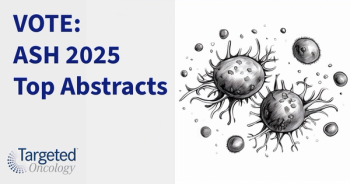
Single-Agent Use of the Bispecific DART Molecule MGD019 Indicates Potential Utility in Pretreated Solid Tumors
Positive safety, pharmacokinetic, and pharmacodynamic data were reported for the first-in-human phase 1 dose-escalation trial of MGD019 during the European Society for Medical Oncology Virtual Congress 2020 as well as preliminary antitumor activity in select tumor types.
Positive safety, pharmacokinetic, and pharmacodynamic data were reported for the first-in-human phase 1 dose-escalation trial of MGD019 (NCT03761017) during the European Society for Medical Oncology (ESMO) Virtual Congress 2020 as well as preliminary antitumor activity in select tumor types.1
The DART molecule was evaluated for safety and determining the maximum tolerated dose in a 3+3+3 design in patients with previously treated advanced solid tumors of any histology. Seven dose cohorts were explored, ranging from 0.3 mg/kg to 10 mg/kg of MGD019, which led to a recommended phase 2 dose of 6 mg/kg. Patients were treated systemically every 3 weeks for the first 24 weeks, followed by every 6 weeks thereafter. Preliminary antitumor effects and pharmacologic end points were also examined.
“MGD019 is a tetravalent bispecific DART molecular with bivalency for both PD-1 and CTLA-4 and an IgG4 Fc backbone,” Manish R. Sharma, MD, PhD, said during a presentation of the data. “Dual blockade of PD-1 and CTLA-4 as a monoclonal combination has been a successful strategy yielding improved efficacy in multiple tumor types.”
Compared with monotherapy agents and combinations inhibiting PD-1 and CTLA-4, preclinical models of MGD019 maintained uncompromised receptor blockade versus the benchmark. “In cells expressing both PD-1 and CTLA-4, such as those found in the tumor microenvironment, MGD019 demonstrated enhanced CTLA-4 blockade by approximately 2 orders of magnitude as compared with anti–CTLA-4 monotherapy and anti–PD-1 plus anti-CTLA-4 combination therapy,” said Sharma, who is a medical oncologist with the Cancer & Hematology Centers of Western Michigan.
One drawback of CTLA-4/PD-1 inhibitor combinations is the high rate of toxicities. In nonhuman primates, MGD019 at all dose levels compared favorably to the combination of nivolumab (Opdivo) plus ipilimumab (Yervoy) in terms of adverse clinical signs, weight loss, gastrointestinal tract inflammation, and cytokine induction. Even at the lowest administered doses, the DART molecule induced T-cell expansion and evidence of CD4+ and CD8+ T-cell proliferation.2
Enrolled patients on the trial (n = 43) had a wide range of tumors types, including gastrointestinal, genitourinary, gynecologic, and lung malignancies. The median age of patients was 62 years (range, 30-85) and most patients had an ECOG performance status of 1 (67.4%). The median number of prior therapies was 3, but most patients had no experience with checkpoint inhibitor blockade (60.5%).
Median duration of treatment in evaluable patients (n = 30) was 12.0 weeks (range, 1.3-60.4). The most common reason for treatment discontinuation was disease progression, except forthe 10 mg/kg group where 38.5% of patients stopped treatment due to adverse effects (AEs).
Linear pharmacokinetics were observed across the dose ranges examined in the trial, with an estimated 12-day half-life. Doses of 6 mg/kg and above achieved steady serum trough concentrations exceeding published data for the PD-1 inhibitor pembrolizumab (Keytruda) at 2 mg/kg every 2 weeks. Sustained peripheral PD-1 receptor occupancy at doses at or above 1 mg/kg were also reported.
Regarding the safety profile of MGD109, patients generally tolerated therapy well at doses less than 10 mg/kg. No dose-limiting toxicities were observed at any dose levels, but a higher rate of grade 3 AEs were observed in the 10 mg/kg cohort, including myocarditis, enterocolitis, hepatitis, bullous dermatitis, and maculopapular rash. Immune suppression with or without treatment interruption or discontinuation resolved most incidences of immune-related AEs. All-grade and grade 3 or greater AEs related to treatment occurred in 79.1% and 32.6% of patients, respectively; the corresponding rate of serious AEs were 41.9% and 37.2%.
Preliminary antitumor activity was observed in a range of tumor types treated with MGD019. Four patients treated at dose levels of 3 mg/kg or higher had an objective response, with 1 case of metastatic colorectal cancer (CRC) having a confirmed complete response. The other 3 patients had partial responses in microsatellite stable CRC, metastatic type AB thymoma, and serous fallopian tube cancer.
“These are tumor types that are typically unresponsive to checkpoint inhibition, and 3 of the 4 responding patients have low baseline PD-L1 expression with a combined positive score of 1 or less,” Sharma said.
No patients treated at dose levels less than 3 mg/kg had an objective response (ORR). Ten patients overall had stable disease as their best response. The objective response rate in the total cohort was 13.3% with a disease control rate (DCR) of 43.3%. When only patients treated with 3 mg/kg were assessed, the resulting ORR was 22.2% and the DCR was 50.0%.
Sharma also reported on various blood-based pharmacodynamic biomarkers, which showed that at doses of 3 mg/kg or higher, MGD019 increased the fraction of Ki67+ T-cells in patients’ peripheral blood mononuclear cells, a marker of T-cell proliferation. Dose-dependent increases in ICOS upregulation, a biomarker specifically associated with CTLA-4 blockade, was also reported. Patients with responses had more ICOS upregulation than those with stable or progressive disease.
“Enrollment in select monotherapy expansion cohorts at the recommended phase 2 dose of 6 mg/kg is ongoing,” Sharma concluded. These tumors types included non–small cell lung cancer, head and neck squamous cell carcinoma, cervical cancer, renal cell carcinoma, microsatellite stable CRC, and soft tissue sarcoma.
REFERENCES
1. Sharma M, Sanborn RE, Cote GM, et al. A phase I, first-in-human, open-label, dose escalation study of MGD019, an investigational bispecific PD-1 x CTLA-4 DART® molecule in patients with advanced solid tumours. Presented at: European Society for Medical Oncology (ESMO) Virtual Congress 2020; September 19-October 21, 2020; Virtual. Abstract 1020O.
2. Selby MJ, Engelhardt JJ, Johnston RJ, et al. Preclinical development of ipilimumab and nivolumab combination immunotherapy: mouse tumor models, in vitro functional studies, and cynomolgus macaque toxicology. PLoS One. 2016;11(9):e0161779. doi:10.1371/journal.pone.0161779









































